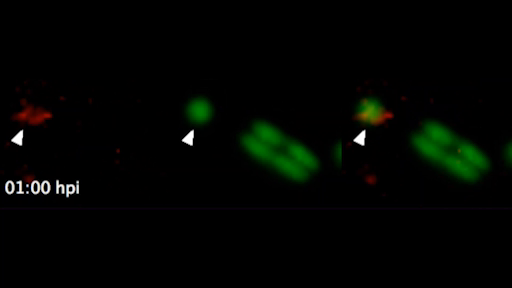3.1 Treating infections with Bdellovibrio bacteriovorus
In the next activity you will look at some recent research that uses Bdellovibrio bacteriovorus to treat infections in an experimental model.
Activity 5 Treating infections with Bdellovibrio bacteriovorus
Listen to the following audio clip from the BBC’s Inside Science programme. Liz Sockett from the University of Nottingham talks about research using Bdellovibrio bacteriovorus to treat Shigella infections in zebrafish. You may also like to watch Video 2 which shows a Bdellovibrio bacteriovorus bacterium (labelled in red) preying on a Shigella bacterium (labelled in green) inside a zebrafish larva.
Transcript: Audio 2 Interview with Liz Sockett about research with Bdellovibrio bacteriovorus.

Using the information in the interview, complete the following statements about the experiment described by Professor Sockett. The missing words are given below to help you.
Bdellovibrio bacteriovorus
Shigella
Zebrafish
Answer
a) Zebrafish were used as the host for the infection.
(b) Shigella infections are normally lethal for zebrafish.
(c) Bdellovibrio bacteriovorus preys on Shigella, killing them and stopping the infection.
(d) As well as killing the Shigella bacteria directly, Bdellovibrio bacteriovorus stimulate the host immune system to help clear the infection.
Now listen to another clip from the same interview in which Professor Sockett discusses how Bdellovibrio bacteriovorus could be used as a treatment and the advantages that this treatment might have.
Transcript: Audio 3 Interview with Liz Sockett about Bdellovibrio bacteriovorus.
Note down in the table below any differences between a potential Bdellovibrio bacteriovorus treatment and antibiotics that Professor Sockett mentions in the audio clip.
| Bdellovibrio bacteriovorus | Antibiotics | |
|---|---|---|
| Type of treatment | ||
| Likelihood of resistance arising | ||
| Tackles antibiotic-resistant bacteria |
Answer
| Bdellovibrio bacteriovorus | Antibiotics | |
|---|---|---|
| Type of treatment | Local injection at site of infection, e.g. a wound | Systemic – taken orally and spreads throughout the body to treat infections at many sites |
| Likelihood of resistance arising | Low – living treatment so can adapt as the infectious pathogen changes Uses many enzymes to kill the bacteria, rather than one specific target, so resistance would require many changes in the infectious bacteria | High – one mechanism of action so may require a single change in the bacteria for resistance arise |
| Tackles antibiotic-resistant bacteria | Yes | No (depending on whether the bacteria are resistant to the prescribed bacteria) |
